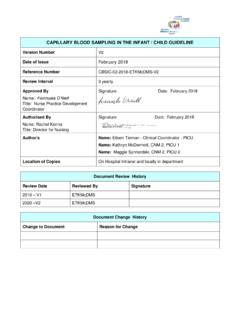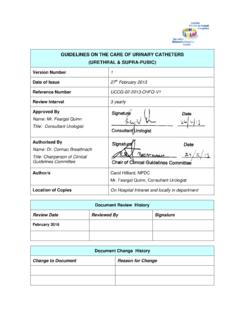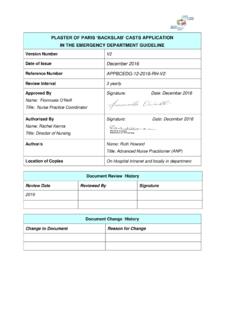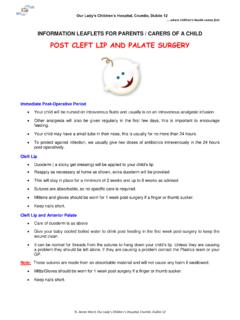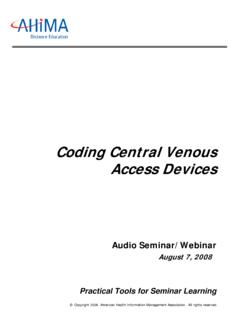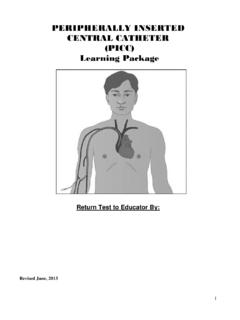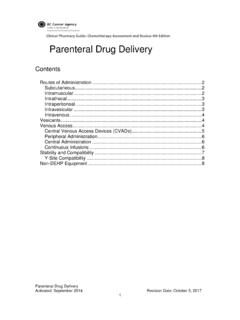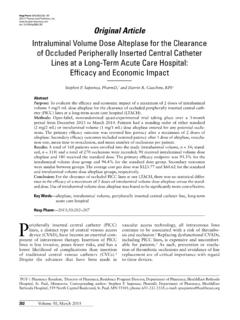Transcription of GUIDELINE FOR CLINICAL STAFF ON THE CARE OF : …
1 GUIDELINE FOR CLINICAL STAFF ON THE care OF : implantable ports Version Number V2 Date of Issue December 2016 Reference Number CVADIP-11-2016-V1 Review Interval 3 yearly Approved By Name: Fionnuala O Neill Title: Nurse Practice Coordinator Signature: Date: December 2016 Authorised By Name: Rachel Kenna Title: Director for Nursing Signature: Date: December 2016 Author/s Name: Fionnuala O Neill Title: Nurse Practice Coordinator Location of Copies On Hospital Intranet and locally in department Document Review History Review Date Reviewed By Signature 2019 Document Change History Change to Document Reason for Change Our Lady s Children s Hospital, Crumlin Document Name: Central Venous Access Devices : implantable ports GUIDELINE Reference Number: CVADIP-11-2016-V1 Version Number: V1 Date of Issue.
2 November 2016 Page 2 of 13 Department of Nursing Central Venous Access Devices (CVAD), is a broad term used to include many catheter types which are inserted into a peripheral/central vein in the body to deliver medications or other therapies to children. A catheter has one end positioned outside the body while a port is surgically placed under the skin and requires a special needle to access it. The most common CVADs include: Peripherally Inserted Central Catheter inserted into one of the peripheral veins in the upper arm.
3 Central Venous Catheter Implanted ports inserted into the subclavian or vein or jugular and attached to a fluid reservoir placed in a surgically created subcutaneous pocket in the upper chest or into an arm vein. Hickman/Broviac catheter Permcath Catheter Umbilical Venous Catheter Our Lady s Children s Hospital, Crumlin Document Name: Central Venous Access Devices : implantable ports GUIDELINE Reference Number: CVADIP-11-2016-V1 Version Number: V1 Date of Issue: November 2016 Page 3 of 13 Department of Nursing CONTENTS Page Number Introduction CVADs 2 Commonly used reference tables Table 3.
4 Blood discard volumes and Flush volumes for CVADS Description 2 General Principles for the care of implantable ports 5 Port Access 5 Insertion of a Cytocan/Gripper Needle and Flushing of implantable Port 6 Procedure 6 Troubleshooting 8 Definition Port Occlusion Port Erosion, Splitting of the catheter Port Pocket Infection Appendix 1 - If needle not in situ 9 Appendix 2 If need in situ 9 References Our Lady s Children s Hospital, Crumlin Document Name: Central Venous Access Devices : implantable ports GUIDELINE Reference Number: CVADIP-11-2016-V1 Version Number: V1 Date of Issue.
5 November 2016 Page 4 of 13 Department of Nursing Commonly used reference tables Table 3. Flush volumes for CVADS Line type Age Blood discard volume Suggested Flush volume for pre and post line use Heparin dose PICC/Midlines It is not possible to withdraw blood from a 1-2fr PICC < 1 year 1ml 10 units/ml 1-3 years 10 units/ml > 3 years 10 units/ml Central Venous Catheters < 1 year 1 ml 10 units/ml 1-3 years 10 units/ml > 3 years 3-5ml 3-5 mls 10 units/ml Hickman/Broviac < 1 year 1 ml As per surgeons 10 units/ml 1-3 years 2 ml As per surgeons 10 units/ml > 3 years 3-5 ml As per surgeons 10 units/ml Implantofix In some cases it may be
6 Requested that blood is withdrawn from an Implantofix. < 1 year N/A 1ml mls 10 units/ml 1-3 years N/A 1ml- 10 units/ml but Use 100units/ml when on discharge for patients with CF > 3 years N/A 10 units/ml Umbilical Venous Catheters < 1 year 1ml 10 units/ml 1-3 years N/A N/A 10 units/ml > 3 years N/A N/A 10 units/ml Permcath-Vascath < 1 year 1ml See GUIDELINE 1-3 years N/A N/A See GUIDELINE > 3 years N/A N/A See GUIDELINE Antibiotic locks must be given using the Pharmacy GUIDELINE as per OLCHC formulary app Description An implanted venous access device consists of a portal body attached to a silicone
7 Catheter. It is implanted subcutaneously in a convenient but inconspicuous location on the body, usually on the chest. Implanted ports require little care of the site because of the intact skin layer over the accessible port. They also require minimal flushing and permit easy access for fluids and/or medications. There is less interference with daily activities and body image is not threatened by the presence of a catheter. The catheter is inserted under general anaesthetic. A semi-circular incision is made to create the pouch to hold the port and a separate incision usually in the neck is made to locate the vein into which the Our Lady s Children s Hospital, Crumlin Document Name: Central Venous Access Devices : implantable ports GUIDELINE Reference Number: CVADIP-11-2016-V1 Version Number: V1 Date of Issue: November 2016 Page 5 of 13 Department of Nursing catheter will be placed.
8 After one end of the catheter is placed in a suitable vein the other end is locked to the port and fluid is injected to ensure the system is working properly. The port is then placed in the skin pocket and secured in place with stitches. The port may be used immediately following insertion. There are two basic parts to the system: The port A small plastic chamber sealed at the top by a rubber disc (septum) designed to withstand multiple punctures. A thin catheter one end is placed into a vein inside the body and the other end firmly attached to the portal with a special lock.
9 General Principles for the care of implantable ports Flushing and Maintaining Patency Prior to accessing the port for flushing and taking blood sampling, the documented port volume plus needle volume should be obtained from the patient s healthcare records. Note: same general principles regarding flushing and maintaining patency as Hickman catheter applies to Port -A - Cath. *Note: Parents are taught to do this at home in some situations. 100 units per ml of Heparinised saline are recommended to flush the Port- A-Cath if the device will not be used for 4 weeks to maintain patency.
10 10 units per ml of Heparinised saline can be used after more frequent drug administration or infusion. Port Access Local anaesthetic cream Amethocaine 4% w/w (Huband & Trigg 2011) may be used prior to accessing the port. The skin should be washed with soap and water first to remove the ointment based anaesthetic cream, followed by cleaning with an antibacterial agent such as Chlorhexidine or Disposable disinfection wipes (70% v/v Isopropyl alcohol and 2% w/v Chlorhexidine gluconate) before accessing the port. A Huber point (non-coring) needle and a 10ml syringe (or larger) should always be used to access the port.
